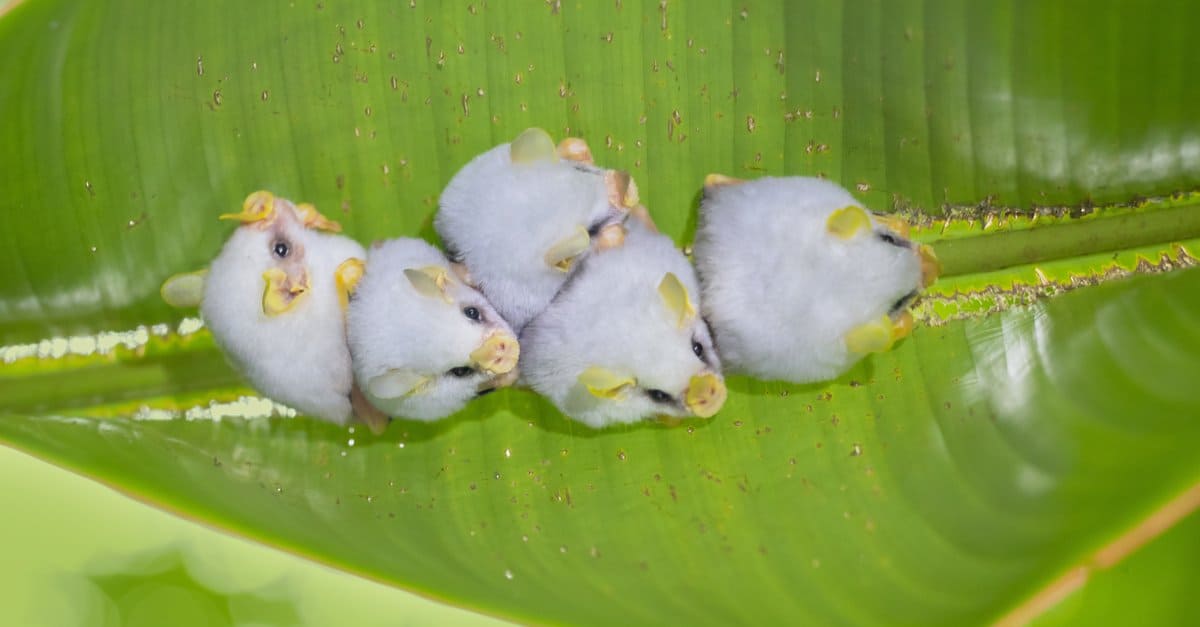Nine Adorable Bats That Prove Nature’s Nighttime Flyers Can Be Cute
While many people might not think of bats as cute, these fascinating creatures have a variety of characteristics that make them intriguing. From their unique adaptations to their often misunderstood roles in ecosystems, bats are more than just creepy nocturnal creatures. Some species are actually quite adorable, with fluffy fur, round faces, and endearing behaviors. Here are nine of the cutest bats found around the world.
9. Northern Ghost Bat
The northern ghost bat is one of the few white-furred bats, with soft, snowy-white to pale-gray fur. It has a distinctive sac on its uropatagium and a vestigial thumb, which sets it apart from other ghost bats. Its pink wing membranes and hairless face add to its unique appearance. This medium-sized bat measures between 3.39 and 4.06 inches long and is found in Central America to Brazil. It feeds on moths and sings while hunting, preferring to roost in palm trees, caves, and old mines. Breeding occurs once a year, typically between January and February.
8. Heart-Nosed Bat
The heart-nosed bat is known for its long, blue-gray fur and unusual predatory behavior. Despite its small size (2.8 to 3.0 inches), it preys on lizards, frogs, and even smaller bats. These bats are monogamous and use singing to establish territory. The father’s songs are believed to help protect the family from intruders. They begin foraging before sunset and are commonly found in the dry lowlands and river valleys of the Horn of Africa.
7. Lesser Horseshoe Bat
Named for its horseshoe-shaped nose leaf, the lesser horseshoe bat is the smallest of its kind in Europe. Measuring only 1.4 to 1.8 inches long, it has gray, fluffy fur and large, petal-shaped ears. It is an agile flyer, hunting insects and small arthropods from rocks, branches, and the air. Solitary by nature, it roosts in trees, caves, and houses, often chattering loudly during the day. Its small size allows it to hide in tight spaces, and when hanging upside down, it wraps its wings around its body like a blanket.
6. Little Yellow-Shouldered Bat
The little yellow-shouldered bat is named for the yellowish fur on its shoulders, which comes from glandular secretions in males. Found across Central and South America, it prefers to roost in trees either alone or in small groups. This bat primarily eats fruits from the nightshade family and occasionally drinks nectar. It does not hibernate and can breed throughout the year. Female bats give birth to one large pup after a four- to seven-month pregnancy, and the young become independent within a month.
5. Common Pipistrelle
The common pipistrelle is a small, cute bat found in Europe, North Africa, and parts of Asia. It measures between 1.09 and 1.27 inches long and has reddish-brown fur with black wings. It uses echolocation to catch insects at night, often foraging near the edges of woods. Twins are relatively common in some colonies, making this species unique among bats. It also forms maternity colonies during breeding season.
4. Little Brown Bat
The little brown bat is one of the most common bats in North America. It measures 3.1 to 3.7 inches long and has dense, glossy fur that ranges from tan to chocolate brown. These bats form large colonies and prefer to live near human habitations. They feed on mosquitoes and fruit flies and are known for their longevity, with some individuals living over 30 years. However, they are threatened by white-nose syndrome, a fungal disease that affects them during hibernation.
3. Peter’s Dwarf Epauletted Fruit Bat
Peter’s dwarf epauletted fruit bat is one of the cutest species, with fluffy brown fur and large eyes. Found in central African forests, it is a megabat despite its small size (2.64 to 4.13 inches). Males have white shoulder hairs that resemble epaulets, which they use to attract mates. These bats eat fruit and nectar, playing an important role in pollination. They breed twice a year, typically in March-May and November.
2. Smoky Bat
The smoky bat is a tiny creature, measuring only 1.5 to 2.28 inches long. It has gray to dark brown fur and is found in forests, pasturelands, and caves in Ecuador, Peru, and Chile. It sometimes forms colonies of up to 300 bats and breeds in June, August, and October. Its diet consists mainly of butterflies and moths, and it is known for its ability to hide in small crevices.
1. Honduran White Bat
The Honduran white bat is one of the rarest and cutest bats, with fluffy white fur and yellow wing tips. Measuring 1.46 to 1.85 inches long, it is found in the rainforests of Central America. These bats sleep together in tents made from heliconia leaves during the day and come out at night to feed on figs. Their unique appearance and behavior make them a fascinating subject for wildlife enthusiasts.






